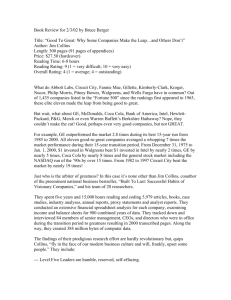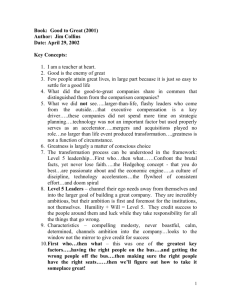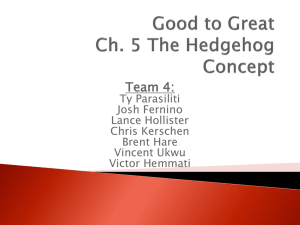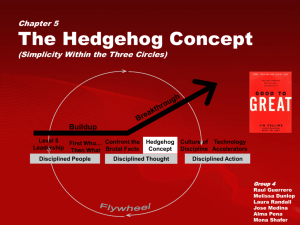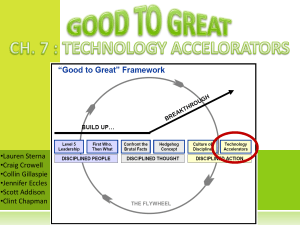The Hedgehog Concept (Simplicity within the Three Circles
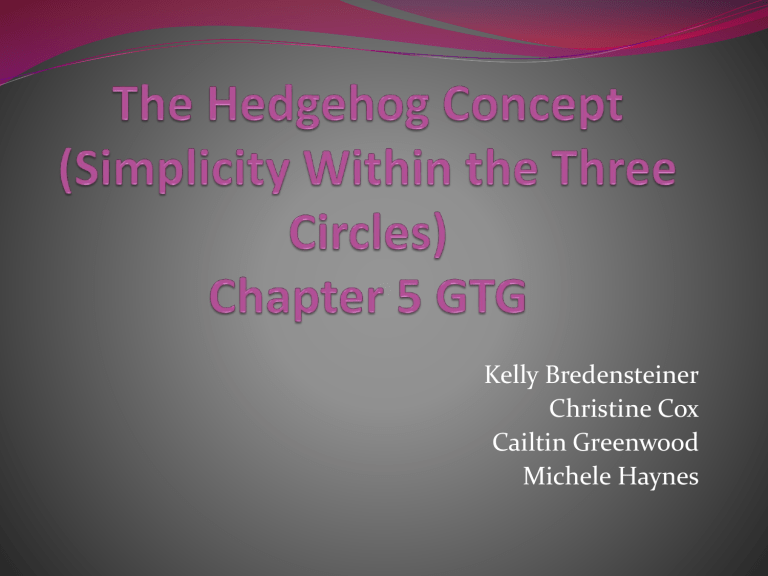
Kelly Bredensteiner
Christine Cox
Cailtin Greenwood
Michele Haynes
Hedgehog or Fox
Fox
Knows many things
See the world in all its complexity and pursue many things at one time
Moving on many levels and are then scattered and are not unified on one concept
Hedgehog
Knows one big thing
Simplify a complex into a single organized idea
Reduces all challenges and dilemmas
Walgreens
Took a simple concept and implemented with fanatical consistency …“The best, most convenient drugstores, with high profit per customer visit.”
Replace all inconvenient locations with convenient ones
Pioneered drive-through pharmacies
Idea of profit per customer visit
Tight clustering of stores - local economies of scale
High-margin services - Increase profit per customer visit
More convenience – more visits more profit per visit
The Three Circles
“A hedgehog Concept is a simple, crystalline concept that flows form deep understanding about the intersection of the following three circles:”
What you can be the best in the world at?
What drives your economic engine?
What are you deeply passionate about?
Three Circles Concept
What Drives
Your
Economic
Engine
What you Are
Deeply
Passionate
About
What you
Can Be the
Best In The
World At
Understanding what you can and cannot be the best at
Put away the ego and understand:
1.
What are you best at?
2.
What are you not best at?
3.
What do you need to change or dump? (outsource?)
Plans vs. Ability
Hedgehog Concept is NOT
what you plan or intend to be the best at
It IS
What you CAN be best at.
Wells Fargo- Keeping it Simple
What it didn’t do well:
International operations
What it did well:
Running a bank like a business esp. in the western US
How it kept it simple:
Dropped most of its IOs
Conclusion:
When deregulation occurred, Wells Fargo was king
Core vs. Ability
Just because its your core.
Just because it’s what you have been doing for years.
Does NOT mean its what you’re best at.
Abbott vs. Upjohn: Changing Cores
Both similar companies in 1964
Why did Abbott change so dramatically?
How it employed the Hedgehog Concept:
Lost chance to be best in pharmaceuticals to Merck
Still chance to provide cost effective health care with
Nutritional and diagnostic services
Money and Growth vs. Greatness
Just because you’re growing and making money,
Does NOT mean you are the best in the world.
“Doing only what you are good at will only make you
good.” (pg 101) Greatness focuses on your best attributes
Ex: SAT’s and the exceptional math student vs. the average student
Companies Employing the
Hedgehog Concept
Gillette
Kimberly-Clark
Kroger
Nucor
Philip Morris
Pitney Bowes
Walgreens
Wells Fargo
Insight Into Your Economic Engine- What is
Your Denominator?
A company does not need to be in a great industry to become a great company
Each good-to-great company built an excellent economic engine
They attained profound insights in their economies
Attained a deep understanding of the key drivers in its economic engine and built its system in accordance with this understanding
Economic Denominator
All good-to-great companies have an economic denominator
Asking one question can lead to profound insight into the inner workings of an organization’s economics
This question is “if you could pick one and only one ratio- profit per x (or, in the social sector, cash flow per x)- to systematically increase over time, what x would have the greatest and most sustainable impact on your economic engine?
Economic Denominator Example
The denominator can be quite subtle, sometimes even unobvious.
The key is to use the question of the denominator to gain understanding and insight into your economic model
You can have more than one economic denominator, but it is better for the company to strive for only one.
Examples of Economic
Denominators
Abbott: per employee
Circuit City: per geographical region
Fannie Mae: per mortgage risk level
Gillette: per customer
Kimberly-Clark: per consumer brand
Kroger: per local population
Nucor: per ton of finished steel
Philip Morris: per global brand category
Pitney Bowes: per customer
Walgreens: per customer visit
Wells Fargo: per employee
Successful Companies Without
Hasbro
Economic Denominators
More sustainable cash flow than big one time hits
Understood all three circles of the Hedgehog Concept
Reintroduced classic brands at the right time
Employees had a passion for the business
Didn’t stay within the three circles after the CEO
Stephen Hassenfeld Died
If you successfully apply these ideas, but then stop doing them, you will slide backward, from great to good, or worse. The only way to remain great is to keep applying the fundamental principles that made you great.
Understanding Your Passion
Many CEOs of companies are passionate consumers of their products
In 1979, Ross Millhiser, then vice chairman of Philip
Morris and a dedicated smoker, said, “I love cigarettes.
It’s one of the things that makes life worth living.”
Passion became a big part of the Hedgehog Concept in good-to-great companies
You cant manufacture passion or “motivate” people to feel passionate. You can only discover what ignites your passion and the passion of those around you.
Understanding Your Passion Cont.
You don’t necessarily have to be passionate about the product but more on what the company stands for.
For example, employees of Fannie Mae were not passionate about the mechanical process of packaging mortgages into market securities. But they were motivated by the whole idea of helping people of all classes. Backgrounds, and races realize the American dream of owning their own home.
The Triumph of Understanding Over
Bravado
Pre-hedgehog
State of fog creating a slow progression on a long march
Hedgehog
Fog lifts and less deliberation is required at each juncture
Post-hedgehog
Quickly make decisions
Great Western vs. Fannie Mae
Great Western
Focused on growing in every way possible
Found itself in finance, leasing, insurance, and manufactured houses on an expansion binge
Fannie Mae
Focused on being the best capital markets player in anything related to mortgages
Inspired workers by its vital role in democratizing home ownership
After 1984 when Fannie Mae clarified its Hedgehog
Concept, the company’s stock charts exploded upward while Great Western lagged around until its acquisition in
1997
Acquiring a Hedgehog Concept
It took about 4 years for the good-to-great companies to clarify their hedgehog concepts
It is an inherently iterative process, not an event
Essence of the process is to get the right people engaged in dialogue and debate, infused with the brutal facts and guided by the questions formed by the 3 circles
The Council can be a useful device for stimulating the process of acquiring a hedgehog concept
The Council
Consists of a group of the right people who participate in dialogue and debate guided by the three circles
Ask the right questions
Engage in dialogue and debate
Make decisions
Autopsy the results
Learn
Hedgehog Concept
Does every organization have a Hedgehog Concept to discover?
Most good to great companies were not the best in the world at anything
Infused with the Stockdale Paradox, every company prevailed in its search
When you get the concept right, it has the quite ping of truth

